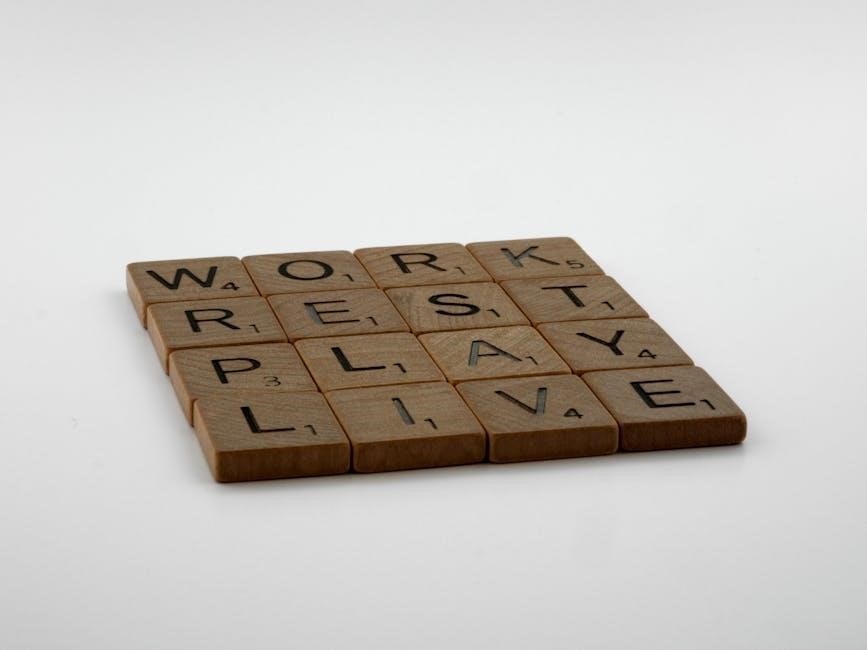The Game of Life is a classic board game simulating life’s journey, focusing on financial management, career choices, and life events, offering both entertainment and education.
1.1 Overview of the Game
The Game of Life is a popular board game that simulates life’s journey, from college to retirement. Players navigate through various life events, making decisions on careers, marriages, and investments. The game is designed for 2-6 players and includes a game board, spinner, and LIFE tiles. The objective is to collect money and LIFE tiles while managing financial ups and downs. The path of life is filled with opportunities and challenges, such as taxes, bonuses, and unexpected expenses. The player with the highest dollar amount at the end wins. It combines strategy and luck, making it both entertaining and educational.
1.2 Historical Context
The Game of Life was first introduced in 1860 by Milton Bradley, making it one of the earliest board games in the United States. Originally designed to teach moral lessons, it featured rewards for good deeds and penalties for bad ones. Over the years, the game evolved to reflect changing societal values. The modern version, launched in 1960, focused on financial and life decisions, offering players a simulation of life’s journey from college to retirement. This edition became a cultural phenomenon, blending entertainment with life lessons. Its enduring popularity has led to numerous updates and editions, keeping it relevant for generations.
1.3 Evolution of the Game
The Game of Life has undergone significant changes since its inception, adapting to societal shifts and technological advancements. The 2007 version introduced updated career options and modern life events, such as cell phones and computers, reflecting contemporary life. Digital versions were later released, allowing players to enjoy the game on mobile devices and computers. These updates ensured the game remained relevant, appealing to both nostalgic players and younger generations. The evolution has maintained the core concept while incorporating fresh elements, keeping it a beloved family game. This adaptability has secured its place as a timeless classic in the world of board games.
Objective of the Game
The objective is to collect money and LIFE tiles while navigating life’s challenges. The goal is to end with the highest dollar amount in retirement.
2.1 Collecting Money and LIFE Tiles
Collecting money and LIFE Tiles is central to the game. Players earn money through salaries, investments, and luck. LIFE Tiles, placed LIFE-side-up, are drawn at milestones, providing bonuses or penalties. Managing expenses and making smart financial decisions is key to accumulating wealth. The goal is to end the game with the most money and LIFE Tiles, ensuring a high final score. Strategic choices, like career selections and stock investments, significantly impact earnings. Balancing risk and reward is essential for long-term success. LIFE Tiles often represent life events, adding unpredictability and excitement to the journey. Effective money management and tile collection determine victory.
2.2 Achieving the Highest Dollar Amount
Achieving the highest dollar amount in The Game of Life requires strategic financial decisions and wise investments. Players must balance earnings from salaries, stock market gains, and LIFE Tile bonuses while managing expenses like taxes and family costs. Smart career choices, such as selecting high-paying jobs or starting a business, can significantly boost income. Investments in stocks or real estate offer opportunities for growth, though they carry risks. Effective money management, avoiding debt, and adapting to life’s unexpected events are crucial. The goal is to maximize wealth by retirement, ensuring the highest total at the game’s end, securing victory.
Setting Up the Game
Place the game board in the center, shuffle and place all cards face down. Set LIFE Tiles and money near the board. Each player receives $10,000. The banker distributes remaining funds. LIFE Tiles are stacked LIFE-side-up. Attach the wheel spinner. Players choose game pieces and place them on “Start.” Everyone is ready to begin the journey.
3.1 Number of Players
The Game of Life is designed for 2 to 6 players. This range ensures dynamic interaction and balanced gameplay. With fewer than 2 players, the game lacks competition, while more than 6 can make it chaotic. Each player selects a token and places it on the “Start” space. The banker distributes $10,000 to each player as starting money. Having multiple players allows for trading, auctions, and joint decisions, enhancing the game’s social and strategic elements. The ideal number of players is 4-6 for optimal engagement and variety in experiences throughout the game.
3.2 Required Components
To play The Game of Life, you need several key components. These include the game board, which depicts the path of life; a spinner for determining moves; and LIFE Tiles, which represent milestones and rewards. Players also need play money for financial transactions, tokens for each player to move around the board, and a banker’s tray to organize funds. Additionally, career cards, salary cards, house cards, and stock certificates add depth to the gameplay. Finally, a set of rules is essential to guide players through setup, gameplay, and winning conditions. These components work together to create an engaging and interactive experience.
3.3 Assembling the Game Board
Assembling the Game of Life board is straightforward. Begin by placing the board in the center of the playing area. Attach the spinner to the designated spot on the board using the provided clip. Next, shuffle and place the LIFE Tiles face down near the board. Prepare the bank by organizing the play money, tokens, and other components. Ensure all players have their chosen game pieces. Finally, distribute the career cards and salary cards to each player based on the instructions. Once everything is set up, the game is ready to start, and players can begin their journey through the Game of Life.

Gameplay Basics
The Game of Life begins with choosing a piece and placing it on the “Start” space. Players spin the wheel, move their piece, and follow space instructions to progress through life’s stages, making decisions on careers, marriages, and investments while managing finances and collecting LIFE Tiles to achieve the highest dollar amount at retirement.
4.1 Choosing a Game Piece
At the start of The Game of Life, each player selects a small plastic token to represent them throughout the game. These tokens, such as a car, spin, or other symbols, are designed to be easily distinguishable. Players choose their piece based on personal preference, as there is no strategic advantage to any specific token. This initial selection is a simple yet symbolic first step, marking the beginning of their virtual life journey. The chosen token will move along the board, navigating through various life stages and events, making the selection a fun and personal way to start the adventure.
4.2 Initial Setup and Bank Preparation
Before starting the game, place the game board in the center of the playing area. Shuffle and place the LIFE tiles face down on their designated spaces. Prepare the bank by organizing the play money, insurance policies, and stock certificates. One player is typically chosen to act as the banker, responsible for distributing and collecting funds throughout the game. Each player begins with a starting amount of $10,000 in cash. Ensure all components are within reach of all players. Proper setup is essential for smooth gameplay, allowing everyone to focus on navigating life’s twists and turns without delays.
4.3 Spinning the Wheel
At the start of each player’s turn, spin the wheel to determine how many spaces to move. The wheel is divided into numbered sections, with most numbers ranging from 1 to 10. Some spaces on the wheel may include special instructions, such as “Pay Day” or “Stock Market.” After spinning, move your game piece the corresponding number of spaces. Landing on certain numbers may also trigger additional actions, like drawing a LIFE tile or paying taxes. Spinning the wheel adds unpredictability and excitement to the game, as players must adapt to the outcomes of each spin and make decisions accordingly.
4.4 Moving Your Game Piece
After spinning the wheel, move your game piece the number of spaces shown. Follow the path on the board, which represents life’s journey. Each space may lead to different outcomes, such as earning money, paying taxes, or encountering life events. When you land on a space, read it aloud and follow the instructions. Some spaces require drawing LIFE tiles, which provide bonuses or penalties. Always move your piece exactly the number of spaces indicated; overshooting is not allowed. Properly aligning your piece on the correct space is crucial for accurate gameplay and fair progression through the game.
4;5 Following Space Instructions
When you land on a space, read the instruction aloud and follow it immediately. Spaces may require you to collect money, pay taxes, or draw a LIFE tile. Some spaces represent life events, such as having children, getting married, or experiencing unexpected expenses. If a space instructs you to draw a LIFE tile, take the top tile from the deck and place it LIFE-side up in front of you. Certain spaces, like “Stock Market” or “Lottery,” may involve additional rules or deductions. Always resolve the action on the space before proceeding to the next turn. Properly following instructions ensures fair and enjoyable gameplay.
4.6 Making Key Decisions
Making key decisions in The Game of Life is crucial for success. Players must decide on careers, whether to marry, how many children to have, and whether to invest in stocks. These choices directly impact earnings, expenses, and overall wealth. For example, choosing a higher-paying career may reduce the number of children you can afford, while marrying can provide financial bonuses. Players must also decide whether to take risks, like investing in the stock market, which can lead to gains or losses. Balancing risk and reward is essential, as these decisions ultimately determine your financial standing at retirement. Strategy is key to maximizing your final wealth. Always consider long-term consequences to ensure the best outcome. Proper decision-making enhances both fun and competitiveness in the game, making it a true reflection of life’s challenges and opportunities.
4.7 Paying Taxes and Collecting Bonuses
Paying taxes and collecting bonuses are integral parts of The Game of Life. As players progress, they may land on spaces requiring tax payments, which can vary based on their career and life choices. Married players may also face joint taxes, increasing their financial obligations. Conversely, bonuses are rewards for achieving milestones, such as collecting LIFE Tiles or landing on specific spaces. These bonuses can significantly boost a player’s wealth. Managing taxes while maximizing bonuses is crucial for maintaining financial stability and achieving the highest possible score at retirement. Strategic decisions about marriage, careers, and investments directly influence these outcomes, adding depth to the game. Properly balancing taxes and bonuses ensures a competitive edge and enhances the overall gameplay experience. This mechanic reflects real-life financial challenges, making the game both educational and entertaining for players of all ages. Balancing these elements is essential for success. Always aim to minimize taxes while earning as many bonuses as possible. This approach will help you accumulate the highest amount of money by the end of the game, securing your victory. Effective management of these aspects is a key strategy for winning. The interplay between taxes and bonuses adds excitement and realism to the game, making each decision impactful. Players must adapt their strategies to optimize their financial outcomes. This balance is what makes The Game of Life a timeless classic, offering both fun and financial lessons. By mastering these mechanics, players can enhance their chances of winning while enjoying the journey through the game’s life stages.
4.8 Retirement and Final Calculations
Retirement marks the end of the journey in The Game of Life. Players stop at the “Retire” space, and final calculations determine the winner. Each player’s total is the sum of their money, LIFE Tiles, and the value of their homes and stocks. The player with the highest total is declared the winner. LIFE Tiles, collected throughout the game, provide bonus points, while debts or taxes owed are deducted. Proper financial management and strategic decisions throughout the game significantly impact the final outcome. Retirement is the culmination of all previous choices, making it a critical moment in achieving victory. The final calculations reveal the player’s overall success. Ensuring accuracy in these calculations is essential to determine the rightful winner. Players must carefully tally their assets and deductions to confirm their final score. This concluding step emphasizes the importance of wise decisions and financial planning. The game’s outcome is decided here, making retirement both exciting and decisive. Accurate calculations are crucial to ensure fairness and determine the ultimate champion. The player with the highest total is celebrated as the winner, reflecting their mastery of life’s challenges and financial strategies. Retirement and final calculations bring the game to a satisfying conclusion, rewarding players for their efforts and decisions. The winner is determined based on their accumulated wealth and LIFE Tiles, showcasing the fruits of their labor. This final step is the pinnacle of the game, where all previous actions come to fruition. The player with the highest score is crowned the champion, completing the journey through the Game of Life. Their total reflects their success in navigating life’s ups and downs, making this moment the ultimate reward. The final calculations are a testament to the player’s strategic prowess and financial acumen, ensuring a memorable conclusion to the game. Retirement is not just an endpoint but a celebration of the player’s achievements throughout the game. The final score serves as a reflection of their overall performance, making the conclusion both thrilling and rewarding. The Game of Life’s retirement phase encapsulates the essence of strategic planning and decision-making, providing a fulfilling end to the journey. Players can look back on their choices, proud of the path they took to reach this moment. The final calculations are the last hurdle, ensuring that only the most skilled and fortunate player emerges victorious. Retirement in the Game of Life is a moment of triumph, where players’ efforts are recognized and celebrated. The game concludes on a high note, leaving players with a sense of accomplishment and satisfaction. The final calculations are the ultimate test of their strategies, and the winner is well-deserved. Retirement marks the end of the adventure, but the memories and lessons learned will linger, making the Game of Life an unforgettable experience. Players can walk away with pride, knowing they gave their best and reaped the rewards of their decisions. The final tally of wealth and LIFE Tiles is the last step in this engaging journey, ensuring that the Game of Life remains a beloved classic for generations to come. Retirement and final calculations are the perfect conclusion to this iconic game, offering a sense of closure and fulfillment. The player’s journey through life comes full circle, and their success is measured in the final moments. This is the heart of the Game of Life, where every decision matters and the outcome is both exciting and rewarding. Retirement is the final chapter, and the calculations are the last page, wrapping up the story of each player’s life. The winner is determined, and the game comes to a close, leaving players eager to embark on new adventures and challenges. The final calculations are the ultimate payoff, making the Game of Life a timeless and engaging experience. Retirement is the grand finale, where players’ efforts are recognized, and their strategies are rewarded. The Game of Life’s conclusion is as memorable as its journey, ensuring that players will return for another round, eager to test their skills once more. The final calculations are the last piece of the puzzle, completing the picture of each player’s life journey. The winner is the one who mastered the art of living, working, and strategizing, making the Game of Life a true classic. Retirement is the end, but the lessons and fun will stay with players forever. The final calculations are the perfect ending to this beloved game, ensuring that the winner is truly deserving of their title. The Game of Life’s retirement phase is a testament to the power of strategic planning and decision-making, providing a satisfying conclusion to the game. Players can reflect on their journey, proud of their accomplishments, and the final calculations serve as a reminder of their hard work and dedication. The winner is the ultimate champion of the Game of Life, having navigated the twists and turns with skill and precision. Retirement is the final destination, and the calculations are the last step, making the game’s conclusion as rewarding as its journey. The Game of Life remains a cherished experience, offering players a chance to relive the excitement of life’s challenges and triumphs. Retirement and final calculations are the perfect ending, ensuring that the game stays in the hearts of players for years to come. The winner is celebrated, and the game comes to a close, but the memories and lessons will endure, making the Game of Life a timeless treasure. The final calculations are the last piece of the adventure, completing the story of each player’s life journey. The winner is the one who excelled in all aspects of the game, from managing finances to making wise decisions. Retirement is the grand finale, and the calculations are the final act, bringing the game to a satisfying conclusion. The Game of Life’s retirement phase is a celebration of the player’s achievements, offering a sense of accomplishment and closure. The final calculations are the ultimate test, determining the rightful winner and concluding the game on a high note. Players can look back on their journey with pride, knowing they gave their best and reaped the rewards of their decisions. The Game of Life remains a beloved classic, offering a unique and engaging experience that continues to captivate players of all ages. Retirement and final calculations are the perfect ending, ensuring that the game’s legacy endures for generations to come. The winner is the champion of their own life story, having successfully navigated the ups and downs of the Game of Life. The final calculations are the last chapter, wrapping up the adventure and leaving players with a sense of fulfillment. The Game of Life’s retirement phase is a testament to the power of strategic planning and decision-making, providing a memorable and rewarding conclusion. The winner is the ultimate achiever, having mastered the art of living and thriving in the game. Retirement is the final destination, and the calculations are the last step, making the game’s conclusion as exciting as its journey. The Game of Life remains a cherished experience, offering players a chance to relive the thrill of life’s challenges and victories. Retirement and final calculations are the perfect ending, ensuring that the game stays in the hearts of players forever. The winner is celebrated, and the game comes to a close, but the memories and lessons will linger, making the Game of Life a timeless classic. The final calculations are the last piece of the puzzle, completing the picture of each player’s life journey. The winner is the one who excelled in all aspects of the game, from managing finances to making wise decisions. Retirement is the grand finale, and the calculations are the final act, bringing the game to a satisfying conclusion. The Game of Life’s retirement phase is a celebration of the player’s achievements, offering a sense of accomplishment and closure. The final calculations are the ultimate test, determining the rightful winner and concluding the game on a high note. Players can look back on their journey with pride, knowing they gave their best and reaped the rewards of their decisions. The Game of Life remains a beloved classic, offering a unique and engaging experience that continues to captivate players of all ages. Retirement and final calculations are the perfect ending, ensuring that the game’s legacy endures for generations to come. The winner is the champion of their own life story, having successfully navigated the ups and downs of the Game of Life. The final calculations are the last chapter, wrapping up the adventure and leaving players with a sense of fulfillment. The Game of Life’s retirement phase is a testament to the power of strategic planning and decision-making, providing a memorable and rewarding conclusion. The winner is the ultimate achiever, having mastered the art of living and thriving in the game. Retirement is the final destination, and the calculations are the last step, making the game’s conclusion as exciting as its journey. The Game of Life remains a cherished experience, offering players a chance to relive the thrill of life’s challenges and victories. Retirement and final calculations are the perfect ending, ensuring that the game stays in the hearts of players forever. The winner is celebrated, and the game comes to a
4.9 Determining the Winner
The winner of The Game of Life is determined by comparing the total assets of all players after retirement. Each player’s total includes their cash, LIFE Tiles, homes, and stocks. The player with the highest total value is declared the winner. If there is a tie, the player with the most LIFE Tiles is awarded the victory. The final calculations are made by summing up all assets and deductions, ensuring accuracy to determine the rightful champion. The winner is celebrated for their successful navigation of life’s challenges and financial decisions, concluding the game on a competitive and satisfying note.

Additional Rules and Mechanics
The game includes trading, taxes, loans, and auctions, adding depth and strategy. Players can also manage joint taxes for married couples and invest in the stock market.
5.1 Trading Between Players
Trading between players adds a dynamic layer to the game, allowing negotiation over LIFE tiles, cash, or other assets. Players can propose trades during their turn, fostering strategic alliances or rivalries. Trades must be mutually agreed upon and completed before the next player spins the wheel. This mechanic encourages social interaction and tactical thinking, as players seek to strengthen their positions or address immediate needs. However, all trades are final and irreversible once agreed, so players must weigh their decisions carefully to avoid disadvantageous outcomes. Trading enhances the game’s unpredictability and fun, keeping players engaged and invested in each other’s progress.
5.2 Joint Taxes for Married Couples
In the Game of Life, married couples can file joint taxes, combining their salaries and deductions. This rule applies when both players land on the “Married” space or choose to marry during the game. Joint taxes are calculated by adding both players’ incomes and applying a single tax rate, which can sometimes result in higher or lower payments compared to individual filings. This mechanic reflects real-life financial planning for couples and adds complexity to the game. Players must strategize whether marrying benefits their financial goals, as joint taxes can significantly impact their final wealth and competitive standing in the game.
5.3 Stock Market Investments
In the Game of Life, players can invest in the stock market to grow their wealth. This optional rule allows players to buy stocks, which can increase in value over time. Investments are made by paying a fee and selecting a stock certificate. Players can earn dividends or sell stocks for a profit. However, there’s also a risk of losing money if the stock market declines. Wise investment decisions can significantly boost a player’s funds, while poor choices may lead to financial setbacks. This mechanic adds a layer of strategy and financial planning, reflecting real-world investment risks and rewards in the game.
5.4 Taking Bank Loans
Taking a bank loan in the Game of Life allows players to borrow money when needed, such as when funds are low or unexpected expenses arise. Players can take loans of $20,000 or $50,000, which must be repaid with interest. The loan is marked with a Loan Marker, and players must pay back the amount plus interest when they land on spaces that require repayment. If a player cannot repay a loan, they risk going bankrupt. Loans provide temporary financial relief but add pressure to manage debt, teaching players about financial responsibility and the consequences of borrowing money.
5.5 Auctions and Negotiations
Auctions and negotiations add a dynamic layer to the game, allowing players to acquire assets or resolve conflicts. When multiple players want the same item, an auction ensues, with the highest bidder claiming the asset. Negotiations enable players to trade or barter, fostering strategic deals. These mechanics encourage bargaining and tactical thinking, as players must weigh risks and benefits. Auctions can lead to overpayment, while negotiations rely on mutual agreement. These elements enhance replayability and social interaction, making each game unique and challenging. Mastering auctions and negotiations is key to maximizing opportunities and minimizing losses in the Game of Life.

Strategies for Success
Effective financial planning, wise investments, and smart decision-making are crucial. Balancing risk and reward, managing resources, and adapting to life’s twists ensure long-term success in the game.
6.1 Effective Financial Planning
Effective financial planning in The Game of Life involves budgeting, saving, and investing wisely. Players should prioritize managing expenses, avoiding unnecessary debts, and strategically allocating resources to maximize returns. By making smart monetary decisions, such as choosing high-paying careers or investing in stocks, players can build financial stability. It’s crucial to balance immediate spending with long-term savings to ensure a secure future. Proper planning helps navigate life’s uncertainties, like taxes or unexpected expenses, ensuring players remain financially resilient throughout the game.
6.2 Wise Investment Decisions
Wise investment decisions are crucial for achieving long-term financial success in The Game of Life. Players should evaluate risks and rewards when choosing investments, such as stocks or real estate, to maximize returns. Diversifying investments reduces vulnerability to market fluctuations. Avoiding impulsive decisions ensures resources are allocated strategically. By aligning investments with career choices and life goals, players can build wealth steadily. Wise investments not only secure funds for retirement but also enhance overall financial stability, helping players achieve the highest dollar amount at the end of the game.
6.3 Managing Risks and Challenges
Managing risks and challenges is essential for navigating the uncertainties of The Game of Life. Players must adapt to unexpected events, such as market fluctuations or life changes, by making informed decisions. Maintaining an emergency fund and avoiding risky investments can safeguard against financial setbacks. Understanding the consequences of choices, like taking loans or paying taxes, helps mitigate potential losses. By balancing caution with opportunity, players can effectively manage risks and overcome challenges, ensuring a stable path toward achieving the highest dollar amount at the end of the game while building resilience for life’s unpredictable nature.

Variations and Expansions
6.4 Making Family Decisions
Making family decisions in The Game of Life involves balancing personal and financial aspects. Players may choose to get married, have children, or remain single, each impacting their financial journey. Marriage and children introduce additional expenses but also bring opportunities for bonuses and shared experiences. Decisions about family size and timing affect cash flow, as raising children costs money but can lead to rewards later. Players must weigh these trade-offs carefully, as they aim to maximize their final dollar amount while navigating life’s milestones. These choices add depth to the game, reflecting real-life dilemmas and encouraging strategic thinking about family planning.
